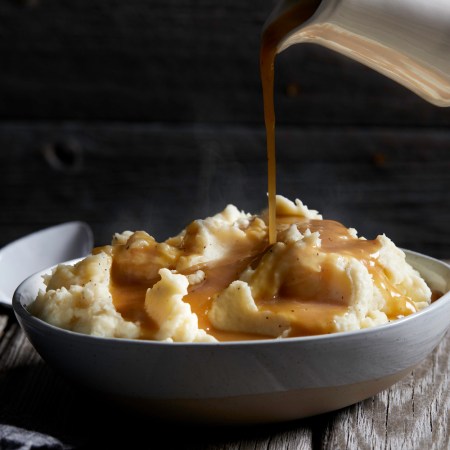A signature dish in southern China, where the cuisine tends to be a bit sweeter and more delicate than it is in the north, sweet and sour pork ribs (“tang cu pai gu“) are typically enjoyed in restaurants, as they can be a bit tricky to perfect at home.
That’s where Andrea Xu, the CEO and co-founder of online one-stop Asian product shop Umamicart, first had the classic cuisine as well. Her experience with the dish does come with a caveat: the restaurant where she first tasted sweet and sour pork ribs belonged to her parents, and the recipe was her father’s. Another caveat? The restaurant was in Spain.
“My first memory of sweet and sour ribs is walking into the kitchen as a kid and seeing my dad with a giant-size wok cooking this dish in bulk for his entire team at the Chinese restaurant my parents owned in Spain,” Xu tells InsideHook. “The smell of it was so awesome. It was just for family meal at the restaurant. This was not the recipe that would be shared with customers. In our restaurant, the sweet and sour ribs looked very different. They were battered and deep-fried in a citrus syrupy sauce.”
The version of the popular pork dish Xu’s father made when she was growing up, which she has shared the recipe for below, gets its sourness from Chinese black vinegar and a bit of a kick from an ingredient that isn’t typically found in sweet and sour ribs.
“We eat a lot of spicy food in my home, so in my family, we make it with Thai chili peppers.,” Xu says. “For me, that adds another layer because now you have sweet, sour and spice. This dish typically doesn’t include that, but my mom loves to eat spicy, so my dad finds a way to incorporate spice in a lot of the dishes he makes. I think in this one it is very unexpected, because there’s already so much going on with sweet and sour, but then when you have it, it’s really not too much. Adding spice really elevates the other two flavors.”

A true triple threat to the taste buds, the dish’s sauce doesn’t just go well with pork ribs, according to Xu.
“The caramelization you get with black vinegar is very different than the caramelization that you would get just with sugar,” she says. “It almost becomes like a dark sticky paste that still looks like a sauce. When you mix it with rice, it’s just the perfect combination. I would definitely recommend saving that sticky sauce to pair with any leftover rice you have. That’s something I used to love as a kid because I didn’t like meat so much. My dad would give me the juice on top of rice and other foods I liked like scrambled eggs. Kids can be picky eaters, so that’s a good hack.”
Even though she’s not a kid with a picky palate anymore, Xu still enjoys her dad’s recipe.
“He definitely got it passed down to him. He’s been a really good cook since he was young,” she says. “He makes noodles, dumplings and buns from scratch and all of that. So he has a lot of recipes he learned from his family that he just enjoys cooking. He loves to make recipes that he grew up eating or recipes that remind him of something special or that his family would make for him when it was a special day. This dish is something that we make when everyone’s kind of just fiending for comfort food. If we really want decadent, this is what my dad will make.”
Umamicart, which is part of Gold House, a spring 2021 accelerator program launched by a nonprofit collective of Asian founders, artists and entrepreneurs, is donating a portion of its proceeds to organizations like the AAPI Community Fund that are working to stop the recent flood of violence against Asian communities in the United States. So if you use the service (which has all the ingredients for Xu’s ribs in a new $45 bundle), you’ll be beefing up your pantry or fridge as well as indirectly helping out a good cause.
Help the world by making some pork ribs — and use this recipe to do it.

Andrea Xu’s Sweet and Sour Pork Ribs
Ingredients
- 2 lb pork spare ribs
- 2 tbsp dark soy sauce
- 1 tbsp light soy sauce
- 1 tbsp Chinese black vinegar
- 1 tbsp sugar
- Salt to taste
- 2 tbsp Shaoxing cooking wine, divided
- 2 ginger knobs (5-10 slices)
- 1 bunch of scallions (white part only), plus more for garnish
- 3 tbsp oil
- 2 cups water
- Red Thai chili peppers (if you want to add a bit of a kick)
Steps:
- Wash the ribs and pat them dry
- Salt the ribs on all sides, then let rest for one hour in the fridge.
- In a large bowl, stir together the light soy sauce and 1 tbsp Shaoxing cooking wine. Add the ribs and let marinate for 15 minutes.
- When ready to cook, make sure the ribs are at room temperature. Cut them into small chunks (if you can’t, large is OK too).
- In a large pot, add water and ribs and bring to a boil. Boil for about 10 minutes, depending on how soft you like your meat. Drain the water and rinse the ribs, then pat them dry.
- In a clean skillet, heat 1 tbsp oil over medium heat, add ginger and scallions and cook until fragrant (two to four minutes). Remove ginger and scallion to a plate and set aside.
- Add another 1 tbsp oil to the skillet, turn heat to high, and add the ribs. Cook on both sides until nicely browned, then add sugar, water, remaining 1 tbsp Shaoxing cooking wine, dark soy sauce, Chinese black vinegar, and the ginger and scallions previously set aside. Add chopped red Thai chili peppers if you want a kick. The ribs should be covered halfway with liquid. Turn the heat to the lowest setting and let simmer for 30 minutes, covered.
- After 30 minutes, check the tenderness of the ribs. If you are satisfied, take the lid off and turn the heat to high. Reduce the sauce until it’s a bit sticky, then adjust soy sauce/vinegar/sugar to taste.
- Remove the pieces of ginger, if desired. Plate and garnish with more chopped scallions.
This article was featured in the InsideHook newsletter. Sign up now.






















